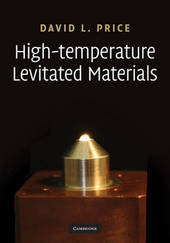
|
High-Temperature Levitated Materials
Hardback
Main Details
| Title |
High-Temperature Levitated Materials
|
| Authors and Contributors |
By (author) David L. Price
|
| Physical Properties |
| Format:Hardback | | Pages:240 | | Dimensions(mm): Height 254,Width 180 |
|
| Category/Genre | Materials science |
|---|
| ISBN/Barcode |
9780521880527
|
| Classifications | Dewey:620.11217 |
|---|
| Audience | | Professional & Vocational | |
|---|
| Illustrations |
151 Halftones, black and white
|
|
Publishing Details |
| Publisher |
Cambridge University Press
|
| Imprint |
Cambridge University Press
|
| Publication Date |
6 May 2010 |
| Publication Country |
United Kingdom
|
Description
One of the major experimental difficulties in studying materials at extreme temperatures is unwanted contamination of the sample through contact with the container. This can be avoided by suspending the sample through levitation. This technique also makes metastable states of matter accessible, opening up new avenues of scientific enquiry, as well as possible new materials for technological applications. This book describes several methods of levitation, the most important being aerodynamic, electromagnetic and electrostatic. It summarizes the state-of-the-art of the measurement of structural, dynamic and physical properties with levitation techniques, the considerable progress made in this field in the past two decades, and prospects for the future. It also explores the concepts behind the experiments and associated theoretical ideas. Aimed at researchers in physics, physical chemistry and materials science, the book is also of interest to professionals working in high-temperature materials processing and the aerospace industry.
Author Biography
David L. Price is Director of Research at Conditions Extremes et Materiaux: Haute Temperature et Irradiation (CEMHTI), Orleans, France. His research interests include order and disorder in solids and liquids, dynamics of disordered systems, the glass transition and melting, neutron diffraction with isotope substitution, deep inelastic and quasielastic neutron scattering, and anomalous, high-energy and inelastic X-ray scattering.
|